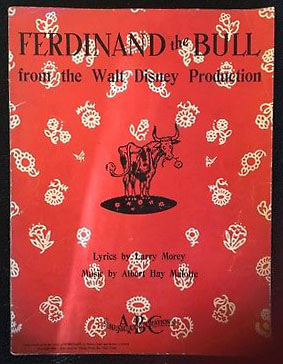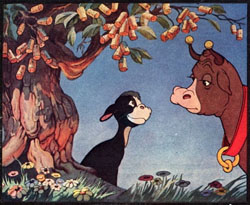 Walt Disney was a very busy man during the spring of 1938.
Walt Disney was a very busy man during the spring of 1938.
He was watching the box-office receipts roll in for “Snow White And The Seven Dwarfs”. He was hearing the songs from the score of that picture, all over the radio of the time. And he was anticipating a bounty from the foreign release of his first animated feature.
But he was not letting the grass grow under his feet!
Disney still had to produce his quota of “Mickey Mouse”, “Donald Duck” and “Silly Symphonies” cartons, for release by RKO. That meant that he needed stories for these shorts.
A couple of years earlier, “The Story of Ferdnand” had proven to be a sleeper hit among children’s books.
The book engendered some degree of controversy. After all, what was Ferdinand, sitting under that cork tree?
Was he a pacifist? . . . a Communist? . . . A Fascist?. . . The controversy was good for sales. And the Disney firm wasted no time in getting the film rights.
The time for gestation of a Disney film was probably much longer than that for, say, one from Walter Lantz, Max Fleischer, or Paul Terry. So, they had plenty of time to figure out how to produce the picture. . . and how to promote it.
And this promotion would–naturaly!–involve a song.
“Ferdinand the Bull” had a melody by Albert Hay Malotte, a composer not used to writing popular or novelty songs.
Apart from “Ferdinand”, Mr. Malotte is best known for a setting of “The Lord’s Prayer” which is heard at some weddings. . . a far and distant cry from chronicling the musical misadventures of a bull that “. . . never learned to fight”.
In-house lyricist Larry Morey handled his job with his usual aplomb. He wold even throw in an allusion to the slogan of a nationally-known dairy.
“For when he’d start to moo, in a moment or two
He’d have all the cows discontented.”
Whereas earlier songs from such “Silly Symphonies” as “The Three Little Pigs” or “The Grasshopper and the Ants”, were put out at about the time that the cartoon was hitting theaters, “Ferdinand the Bull” was being sent to bandleaders and record companies a good seven months before the cartoon was released into theaters.
 Thus, the song may have been very profitable, and served to promote the upcoming release of the short.
Thus, the song may have been very profitable, and served to promote the upcoming release of the short.
The song was covered widely in this country. . . in Great Britain. . . an even in the German of the National Socialists!
With “Ferdinand the Bull”, the Walt Disney firm decided to use a song to promote an upcoming cartoon.
Besides, there might have been some folks who were not yet familiar with Munro Leaf’s original book,”The Story Of Ferdinand”. “Plugging” of the song seems to have begun in late April of 1938–seven months before the cartoon was released.
On the 29th of that month, the first recording was made–by an unlikely band with an unlikely singer.
Larry Clinton had become famous among “alligators” and other aficionados of ‘swing”, due to his arrangements and compositions. He put together groups of studio musicians, and his records had become so popular that he had to take a working band “on the road”.
Beatrice Wayne–who was starting to appear in public as “Bea Wain’–had been singing on radio and records with various bands for several years.
Clinton’s band and Bea’s voice were wrapped around this number, which was duly issued. I’ve not heard it lately, so I don’t know if Clinton played it in the three-quarter time in which it was written, or whether he attempted to “swing” it.
One artist who did try to swing it was Slim Gaillard-who was, at the time,the talk of 52nd. Street. in Manhattan.
Bulee Gaillard was the quintessential hipster, and played that role for a good dozen or more years, He would be successful with jazz and swing fans, and would have hit records into the middle 1940’s, when his “Cement Mixer (Put-ti, Put-ti)” was heard all over the place.
They were just coming off the enormous success of “Flat Foot Floogie” (“. . . with a floy-floy”), when they cut a swing version of “Ferdinand” for the thirty-five cent Vocalion label.
Vocalion also released a more conventional version of the taurine opus, with Terry Shand’s brand-new band playing it. Shand had been pianist with Freddy Martin, and had taken the occasional vocal–especially if it wasn’t a romantic ballad.
 The expensive Brunswick label gave the waltz to an up-and-coming stage band that had made a name for itself on radio broadcasts. Horace Heidt was handed the song, and among his large array of vocalists were the ones who got to do the heavy lifting: the King Sisters (Still a trio at the time–a fourth would join soon afterward.)
The expensive Brunswick label gave the waltz to an up-and-coming stage band that had made a name for itself on radio broadcasts. Horace Heidt was handed the song, and among his large array of vocalists were the ones who got to do the heavy lifting: the King Sisters (Still a trio at the time–a fourth would join soon afterward.)
Over at Decca, the song was given to Dick Robertson, who was singing on a series of jukebox-oriented discs which bore his name as leader. He gets a verse and a couple of choruses, and handles them in his usual businesslike manner.
Curiously, two other recordings came out around the time the film was released. And they were aimed at the “hillbilly” end of the market–although they were both more in the nature of “novelty”performances.
Dave Durham and his Dixieland Swingsters was a group operating out of a powerful radio station in Charlotte, North Carolina. They had recorded there in August,1937. But when they recorded for Bluebird in October, 1938, the session was held in Rock Hill, South Carolina–apparently an attempt to get away from the Charlotte local of the American Federation of Musicians.
The Durham version is notable for including several vocal choruses not usually found on versions of the song.
Their Vocalion recording was issued twice in quick successon–firstly coupled with a Crismas holiday selection, then again with a song that had nothing to do with the season.
And finally, here is a German recording from 1938 with Teddy Stauffer and the Original-Teddies; vocal: Billy Toffel.
BONUS TRACK: This kinescope of the The Lennon Sisters on The Lawrence Welk Show proved the song had an afterlife in the years that followed.


 James Parten has overcome a congenital visual disability to be acknowledged as an expert on the early history of recorded sound. He has a Broadcasting Certificate (Radio Option) from Los Angeles Valley College, class of 1999. He has also been a fan of animated cartoons since childhood.
James Parten has overcome a congenital visual disability to be acknowledged as an expert on the early history of recorded sound. He has a Broadcasting Certificate (Radio Option) from Los Angeles Valley College, class of 1999. He has also been a fan of animated cartoons since childhood.











































…Bea Wain died just this last year. As I write this, I am watching Snow White being endlessly rd-ten on Freeform. At the enf, when Snow White kisses the Dwarves goodbye, she only seems to kiss six of tbem! Was one left out? Or did exiting Freeform edit a touch?
It was always that way. Frank Thomas was assigned that scene and said he had trouble trying to keep up count while animating the scene.
Snow White indeed only kisses six of the Dwarfs. It’s easy to miss but at one point she looks down and waves. This is apparently her good-bye to Sleepy, the one she doesn’t kiss. Perhaps Sleepy was just too tired to present himself. In reality it was probably a matter of staging and timing. Most people don’t notice that only six are kissed.
I don’t know if you’ve made this clear, James, but the lyrics of the song called “Ferdinand The Bull” were NOT in the soundtrack of the cartoon. I’m not even sure that any of the melody was used, either, maybe just the briefest of snippets. The other Silly Symphony songs WERE used in the soundtracks, such as “The World Owes Me A Living”, “You’re Nothin’ But A Nothin'” and “Wynken, Blynken and Nod” to name three.
Is the melody to Ferdinand the Bull protected under copyright? I would like to write a parody of the chorus to celebrate a friend who is turning niintty at the end of May. Her party will be held at a local pub in Albuquerque, NM. and will only be a one-afternoon event. Thank you for any help you can provide.